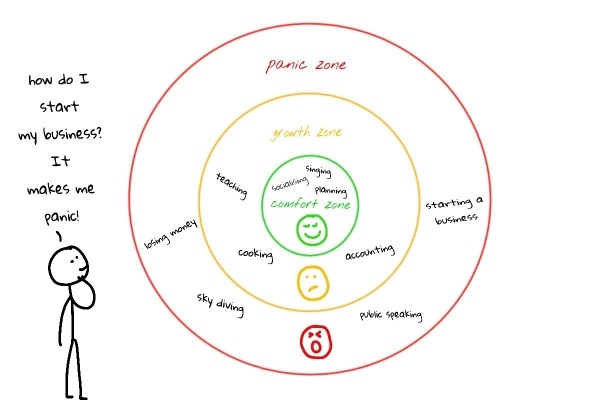 A Coaching Power Tool Created by Julie Kong
A Coaching Power Tool Created by Julie Kong
(Introverted Woman Leader Coach, SINGAPORE)
In various coaching sessions I had, there is a common reason that is often shared which prevents the coachee from reaching a goal: laziness. “I feel lazy to change… I am lazy to start this initiative. I am lazy to impose myself on a new schedule…“
How would you define laziness?
What challenges are you hiding behind this expression?
If we refer to the standard definition seen in Wikipedia or Cambridge dictionary, laziness is
a disinclination to activity or exertion despite having the ability to act or to exert oneself, it is the quality of not being willing to work or use any effort.
From this perspective, we understand that it is not a physical inability or lack of capacity to act but a willingness or motivation to start moving.
What drives your motivation to achieve your plan?
How much effort does it require for you to shift to a committed motion mode?
Sigmund Freud associated this motivation default to the pleasure principle that can be derived as follows:
We become lazy as soon as our underlying beliefs come against our actions. When actions are questioned or inconsistent with the expectations we are slowing down and are taking less seriously the targeted intention.
How do you feel when you become lazy? Do you feel oppressed or in the opposite relaxed?
Do you feel empowered or frustrated?
Application – The comfort zone
Associating laziness with our habit might raise a pleasant feeling.
Let’s take the example of The comfort zone notion. We often refer to work to be in the comfort zone when we have reached good skills and mastered a domain or topic. It comes after having a few years of experience in this particular field and consequently after being through training and several related projects. This is the period when we feel less stressed, more efficient, and more comfortable as the tasks performed are known and easy. A routine is set in a safe and comfortable environment.
Through this comfort zone, all uncertainty and risk are banned turning the day-to-day into monotony and passivity. Finding its comfort zone is similar to reaching recognition for the work and effort performed. However, remaining in this stage too long could impact the expected positive outcome. As we are reaching the peak of the learning curve and we are getting rid of all pressure, we are tented to limit actions and exposure. We could be struggling with incentives to continue in this area due to the lack of excitement and change.
This case highlights the importance to keep moving and learning instead of only leveraging on its granted.
Case Study – Millennials generation and Technology
If we look at the case of the generation called Millennials. They are often associated with laziness and are considered difficult to manage in a company due to their instability or narcissism. Millennials refer to the generation of people born between the early 1980s and 1990s. Grown-up with technology, they are the first workforce raised with social media and unlimited information. Accessing a variety of sources coming to contradict the rules, to make them dream of better life balance, they are forced to be innovative and agile in a fast-paced environment. Looking at the external factors, this generation should be inspired to be successful. However, they are more described as uncontrollable and egocentric.
Now let’s look at why they are defined as lazy and let’s link that to Millennials’ own beliefs.

From these examples of behavior cases, there is no doubt that Millennials are rejecting the former society/generational values and the gap is translated into lazy reactions or rebellion. As they are more receptive to new ideas and are more agile in their working style, they tend to seek faster outcomes and benefits which is accelerated by the technology context (digital transformation, internet, social connectivity). Information is now more fluid and transparent which gives less chance to management error. It also questions the long-term initiatives. As technology fastens and amplifies the results, there is a strong inconsistency in the reward and work expectations.
This could lead to managers to abandon this workforce and reciprocally Millennials to slow down their engagement and set relaxed and nonproductive rules. In this high-speed technology, resilience is difficult to teach to Millennials and laziness is the consequence of this mismatch.
Motion makes you grow
From the 2 examples shared before, the way to feel empowered would be to keep moving and accepting the change across the society or the company. Being in motion unlock potential and possibilities while laziness creates additional fear and emphasizes stress.
The comfort zone is the great enemy to creativity; moving beyond it necessitates intuition, which in turn configures new perspectives and conquers fears. – Dan Stevens
Whatever actions are taken, long or fast, this would trigger a change and new learning skills. This might trigger new interests and open to new perspectives and motivation. Actions come with the risk that can be set and measurable. Being in motion helps to build the foundations of experience and confidence. With technology, it is now easier and faster to move, to fail, to try again, and learn from mistakes. Actions are nowadays less judged than passivity or procrastination. This is the core principle of the new digital trend and working method such as machine learning, AGILE project mode… We are experimenting with a time when results and productivity are differently defined.
Market and society pace is more volatile and uncertain. Therefore growing its comfort zone and keep moving is essential to cope with the fast changes and new rules of the modern society where influencers play a key game.
Reflection
- Where is your comfort zone? List all elements making you lazy and inactive
- What are the incentives to go out of your comfort zone? List all elements putting you in motion
- How can you connect these laziness and motion elements? How far are they from?
- By being in motion, how can you grow your comfort zone? How do you feel about growing your comfort zone?
- Which fear do you have by being in motion?
- In motion where are you aiming to go? How does it improve your future?
- Which support can you get to keep being in motion?
Coaching Application
As a coach, we can empower the client by understanding what it prevents it from being active and finding the motivation to accept it to change and to take risks. Bringing some awareness of the situation and the reason why we don’t want to proceed or why we want to change helps to qualify the complexity, the fear, and the ultimate goal.
By making it visualized the future and its potential, the client can determine its true value and its level of confidence to achieve its target. Laziness comes when the goal seems unachievable or far away. Designing a path with small steps and mini success helps to build confidence and determination in the long run.
Listening to the client’s emotions are important to better understand how it affects itself and how it drives its behavior. Does the change create panic or stress? Which actions could contribute to a positive accomplishment and a feeling of satisfaction?
As a coach, we believe the client is the best to find the solution and its level of control to put in motion for a positive outcome. Through tools related to emotional intelligence, visualization, perspectives, and action design, we facilitate this outcome.

References
https://en.wikipedia.org/wiki/Laziness
https://dictionary.cambridge.org/dictionary/english/laziness
https://www.psychologytoday.com/sg/blog/hide-and-seek/201410/the-psychology-laziness
https://www.thepositivepsychologypeople.com/art-getting-comfort-zone/
https://psychology-spot.com/comfort-zone/
https://www.psychreg.org/comfort-zone-personal-growth/
https://www.lifehack.org/articles/work/8-reasons-millennials-seem-lazy-work.html
https://time.com/247/millennials-the-me-me-me-generation/
https://whatis.techtarget.com/definition/millennials-millennial-generation
https://www.livescience.com/38061-millennials-generation-y.html